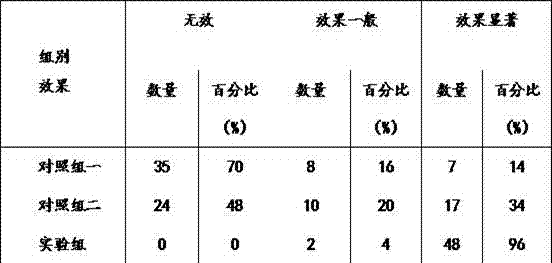Traditional Chinese medicine for treating amoebic dysentery and preparation method thereof
A technology for amoebic dysentery, which is applied in the field of traditional Chinese medicine for treating amoebic dysentery and its preparation, can solve the problems of inability to alleviate the pain of patients, and the curative effect is not significant, and achieve the effect of significant curative effect and pain relief
- Summary
- Abstract
- Description
- Claims
- Application Information
AI Technical Summary
Problems solved by technology
Method used
Image
Examples
Embodiment 1
[0020] A traditional Chinese medicine for treating amoebic dysentery. Brucea javanica 5 parts, ambrette 11 parts, Gentiana japonica 19 parts, Jin Jinxiang 22 parts, Sophora 3 parts, snakeberry 14 parts, safflower 9 parts, white grass 8 parts, flying grass 10 parts, asparagus 13 parts, 6 parts of Myrrh, 5 parts of Patrinia, 9 parts of Cliff Pine and 12 parts of Purple Back Vegetable.
[0021] A preparation method of a Chinese medicine for treating amoebic dysentery, comprising the following steps:
[0022] 1) Combine 25 parts of Geshanxiang, 6 parts of iron amaranth, 7 parts of native tea, 6 parts of basil, 15 parts of garlic, 13 parts of small arrowhead, 5 parts of Brucea javanica, 11 parts of ambrette, 19 parts of Gentiana japonica, Jin Jinxiang 22 parts and 3 parts of bitter beans are quick-frozen in liquid nitrogen and set aside;
[0023] 2) Take out the medicinal material obtained in step 1), put it into a pulverizer, adjust the speed to 1500-2000r / min, pulverize it for ...
Embodiment 2
[0029] A traditional Chinese medicine for treating amoebic dysentery. 8.5 parts of Brucea javanica, 14 parts of ambrette, 19.5 parts of Gentiana japonica, 23 parts of Jin Jinxiang, 6 parts of bitter bean, 16 parts of snakeberry, 10.5 parts of safflower, 10.5 parts of white grass, 12.5 parts of flying grass, 15.5 parts of asparagus, 7 parts of myrrh, 7.5 parts of Patrinia, 10.5 parts of pine pine and 13 parts of purple back vegetable.
[0030] A preparation method of a Chinese medicine for treating amoebic dysentery, comprising the following steps:
[0031] 1) Combine 32.5 parts of Geshanxiang, 7 parts of iron amaranth, 9 parts of native tea, 8 parts of basil, 17.5 parts of garlic, 15.5 parts of a small arrowhead, 8.5 parts of Brucea javanica, 14 parts of ambrette, 19.5 parts of Gentiana japonica, Jin Jinxiang 23 parts and 6 parts of bitter beans are quick-frozen in liquid nitrogen and set aside;
[0032] 2) Take out the medicinal material obtained in step 1), put it into a p...
Embodiment 3
[0038] A traditional Chinese medicine for treating amoebic dysentery. Brucea javanica 12 parts, Ambrette 17 parts, Gentiana japonica 20 parts, Jin Jinxiang 24 parts, Sophora 9 parts, Snakeberry 18 parts, Safflower 12 parts, Vermicelli 13 parts, Flying grass 15 parts, Asparagus 18 parts, 8 parts of myrrh, 10 parts of Patrinia, 12 parts of pine pine and 14 parts of purple back vegetables.
[0039] A preparation method of a Chinese medicine for treating amoebic dysentery, comprising the following steps:
[0040]1) Combine 40 parts of Geshanxiang, 8 parts of iron amaranth, 11 parts of native tea, 10 parts of basil, 20 parts of garlic, 18 parts of small arrowhead, 12 parts of Brucea javanica, 17 parts of ambrette, 20 parts of Gentiana japonica, Jin Jinxiang 24 parts and 9 parts of bitter beans are quick-frozen in liquid nitrogen and set aside;
[0041] 2) Take out the medicinal material obtained in step 1), put it into a pulverizer, adjust the speed to 1500-2000r / min, pulverize i...
PUM
 Login to View More
Login to View More Abstract
Description
Claims
Application Information
 Login to View More
Login to View More - R&D
- Intellectual Property
- Life Sciences
- Materials
- Tech Scout
- Unparalleled Data Quality
- Higher Quality Content
- 60% Fewer Hallucinations
Browse by: Latest US Patents, China's latest patents, Technical Efficacy Thesaurus, Application Domain, Technology Topic, Popular Technical Reports.
© 2025 PatSnap. All rights reserved.Legal|Privacy policy|Modern Slavery Act Transparency Statement|Sitemap|About US| Contact US: help@patsnap.com

